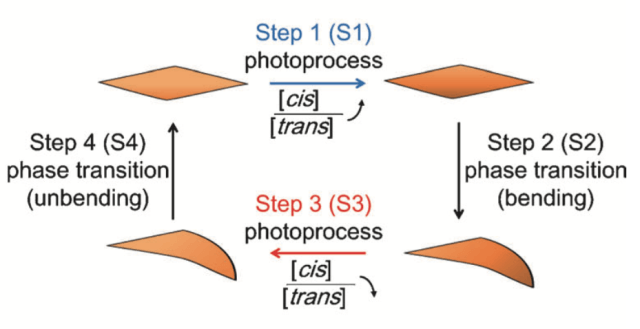Jul 7 2016
Light-powered molecular motors have been created by scientists from Hokkaido University. The motors bend and unbend repeatedly, and could lead to the development of molecular robots.
 Schematic illustration of each step of the self-oscillatory motion. (Credit: Ikegami T. et. al., Angewandte Chemie International Edition, May 19, 2016)
Schematic illustration of each step of the self-oscillatory motion. (Credit: Ikegami T. et. al., Angewandte Chemie International Edition, May 19, 2016)
Efforts are under way to develop molecular motors that, like cellular systems, can carry and deliver drugs to desired tissues. The design of such motors could lead to the development of molecular robots that can perform more complex missions. In order to achieve this, ways to transform motion from a molecular to a macroscopic level are essential. In addition, researchers must also develop methods to ensure that chemical reactions can take place in a repeated and independent manner.
A crystalline assembly or chemical compound, which can independently and repetitively flip under blue light, has been developed by Yoshiyuki Kageyama, Sadamu Takeda and team from the Chemistry Department of Hokkaido University.
Microscopy of self-oscillation of the crystalline assembly - DOI: 10.1002/anie.201600218
Microscopy of self-oscillation of the crystalline assembly
A crystalline assembly of azobenzene derivative and oleate showed oscillatory bending-unbending motion under continuous 435 nm light irradiation. The frequency of oscillation increased with increasing light intensity. (Ikegami T. et. al., Angewandte Chemie International Edition, May 19, 2016)
The researchers used oleic acid, a common component of cooking oil and azobenzene, an organic compound that is used to produce dye, to create crystals. Azobenzene molecules continuously shift between two structural forms – trans and cis – under blue light. The scientists conducted experiments to see if this repeat shifting would have an impact on the structure of crystals that are created using azobenzene and oleic acid. The azobenzene-oleic acid crystals have different amounts of trans- and cis- azobenzene.
The team applied blue light to crystals in solutions and observed the reactions under a microscope. They noticed an oscillatory motion in the crystals of bending and unbending, influenced by the ratio of cis-and trans-azobenzenes. This motion hints at the presence of two stable structures. They also observed that when there was an increase in intensity of light, there was a corresponding increase in the frequency of the motion. “Swimming-like” motions were also observed in some crystal complexes, when in water. Materials that were reported as being responsive to light have not exhibited a strong ability to deform. However, the crystals created by the team from Hokkaido were able to perform a two-step switching motion, due to the characteristic of their compounds, which created a continuous, repetitive oscillatory motion.
The ability to self-organize rhythmic motions, such as the repetitive flipping motion we observed, is one of the fundamental characteristics of living organisms. This mechanism can be used in the future to develop bio-inspired molecular motors and robots that will find applications in wide areas, including medicine.
Yoshiyuki Kageyama, Chemistry Department, Hokkaido University